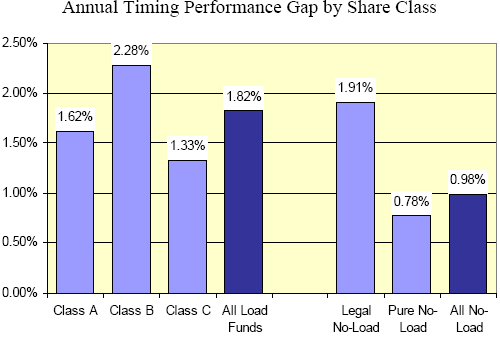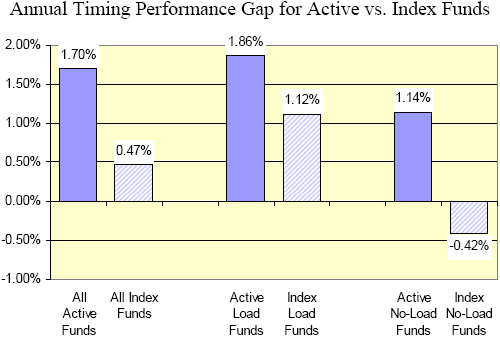Mutual fund investors have two ways to beat the market: (1) pick the right funds, and (2) time their purchases and sales. How effectively does the average fund investor execute the latter goal? In their December 2007 paper entitled “Investor Timing and Fund Distribution Channels”, Mercer Bullard, Geoff Friesen and Travis Sapp examine the investment timing performance of equity mutual fund investors and the relationship of this performance to the fund distribution channel. Using data on returns and funds flows for 6,164 U.S. equity mutual funds during 1991-2004, they conclude that:
- Mutual fund investors who buy and sell through fund-compensated investment advisors exhibit substantially poorer timing than investors in pure no-load funds.
- Specifically, investors in load funds and legal no-load funds (no load but a modest 12b-1 fee) lag the performance of these funds by 1.82% and 1.91% per year, respectively. Investors in deferred sales load (pure no-load) funds show the worst (best) timing, underperforming a buy-and-hold strategy by 2.28% (0.78%) annually. (See the first chart below.)
- Investors in actively managed mutual funds have an annual timing deficit (1.70%) more than three times that of index fund investors (0.47%). Investors in no-load index funds capture a slight (statistically unreliable) timing surplus, suggesting that the smartest money goes into these funds. (See the second chart below.)
- The worst investor timing tends to occur among funds of the largest size, highest volatility and best risk-adjusted past performance.
- A possible explanation for these results is that the most naive investors, perhaps egged on by commission-seeking advisors, chase recent performance.
- Independent of investor timing, all classes of funds examined exhibit negative risk-adjusted returns, with deferred sales load (pure no-load) funds the most (least) negative.
The following chart, taken from the paper, summarizes by fund class the degree to which mutual fund investors underperform because of the timing of their purchases and sales. Funds class definitions are:
- Class A shares have a front-end load.
- Class B shares have a deferred sales load (paid upon sale) in excess of 1%.
- Class C shares have either a deferred sales load of 1% or less or a 12b-1 fee over 0.25%.
- Legal no-load funds have no loads and 12b-1 fees under 0.25%.
- Pure no-load funds have no loads and no 12b-1 fees.
The chart shows that, on average, mutual fund investors lose ground by market timing, with investors in deferred sales load (pure no-load) funds suffering most (least).

The next chart, also from the paper, recasts results to distinguish between actively managed mutual funds and index mutual funds. It shows that investors in index funds exhibit better market timing than investors in actively managed funds. Investors in no-load index funds actually gain a little ground on the market via timing of purchases and sales, suggesting that they are the most sophisticated of the groups tested.

In summary, mutual fund timers on average underperform passive buy-and-hold mutual fund investors. Investors who use fund-compensated investment advisors exhibit particularly bad timing.